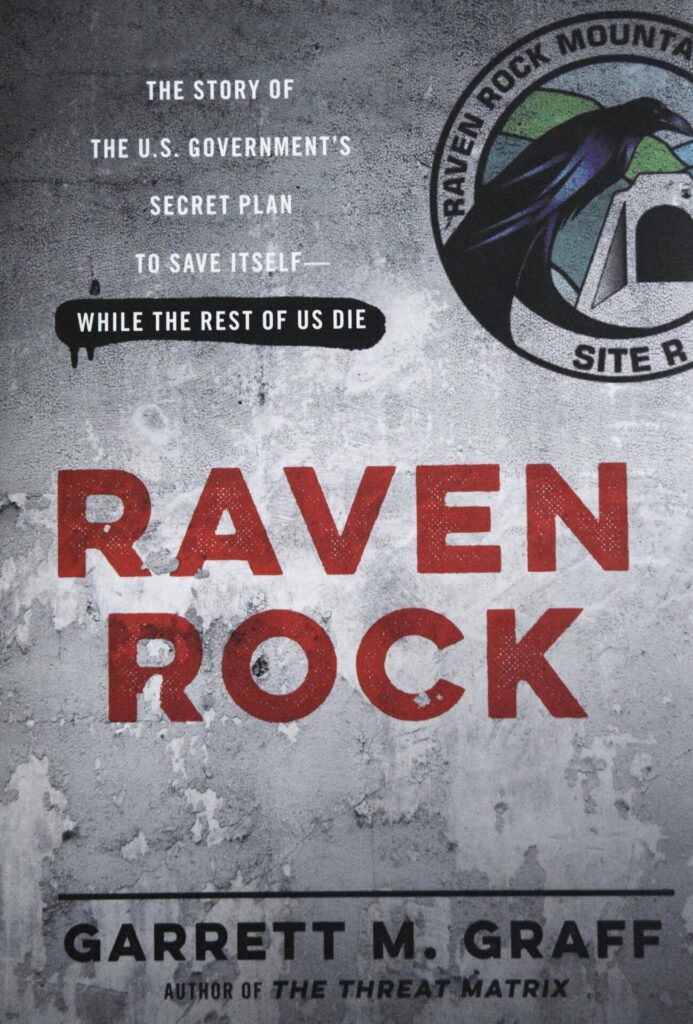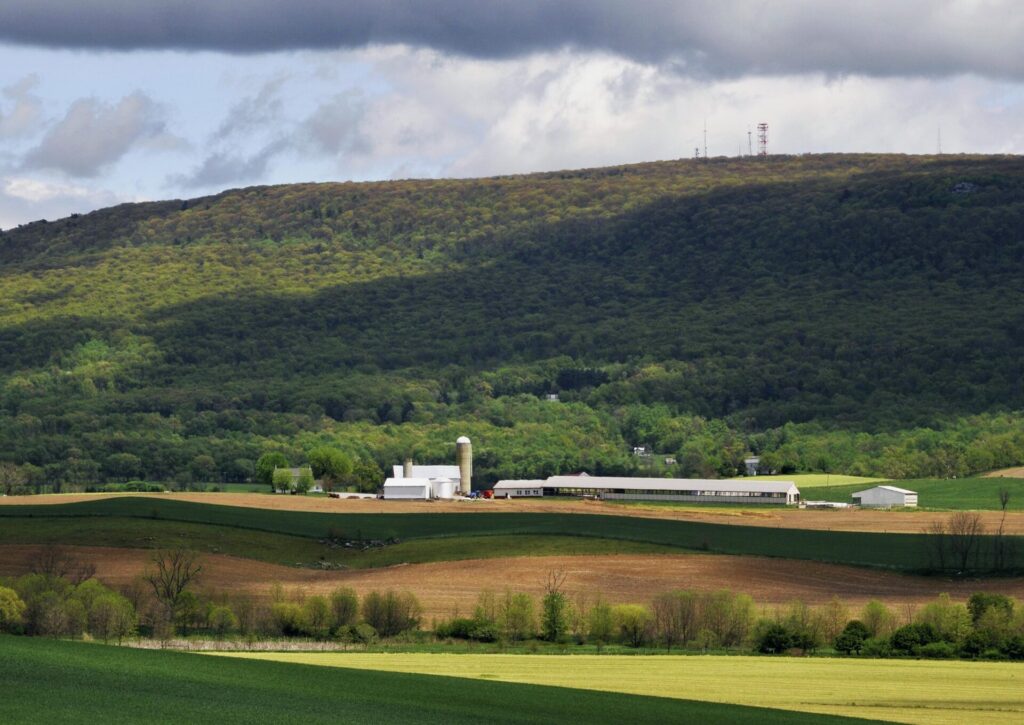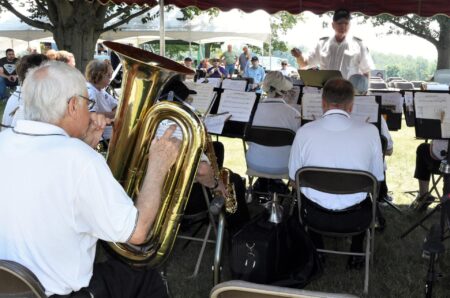‘Raven Rock: The Story Of The U.S. Government’s Secret Plan To Save Itself While The Rest Of Die’- By Garrett M. Graff, 409 pages, Simon & Shuster, Publisher

In World War II’s aftermath, the planet’s population faced a sobering reality: uncertain survival in a nuclear age begun after a horrific new weapon was unleashed. During the decades that followed the dropping of an atomic bomb in 1945, the U.S. and its foes began an arms race that not only changed modern warfare, but all of human civilization.
Garrett Graff’s book, ‘Raven Rock’, expertly details how the U.S. grappled with the grim responsibility of protecting its citizens from an enemy nuclear attack, which at times seemed inevitable during the Cold War. But this book also examines how the government conducted secret plans for itself, since shielding an entire national citizenry from potential nuclear catastrophe eventually proved impossible.
Southern Pennsylvania was a pivotal location included in a series of underground bunkers the U.S. Military carved beneath mountains. These facilities were designed to serve as headquarters for a displaced government, should the nation’s worst doomsday fears come true. The most important acronym explained in Graff’s book is ‘COG’ or ‘Continuity of Government’.
‘Raven Rock’ is chosen as Graff’s COG symbol for a network of clandestine U.S. underground facilities. Raven Rock is also a real place, also known by a military code name, and by the public as the ‘Underground Pentagon’. This massive bunker is located in nearby Adams County. The hidden properties of this facility, and others like it around the country, are continuing mysteries to this day.
Graff’s book begins with the Truman administration, and follows a succession of U.S. Presidents as they struggle with an ever-evolving nuclear threat. Truman himself had no knowledge of the Manhattan Project, the top-secret government program that developed an atomic bomb, when he became President following Franklin Roosevelt’s death. Four months into his presidency, Truman decided the swiftest way to end World War II was dropping history’s first atomic bombs on Japan. The conflict thankfully concluded soon after, but warfare would never be the same.

This event also altered U.S. society overnight. Scholars and governmental experts preached strange new solutions to threats of total nuclear destruction. One idea was prominent: Go underground. Graff describes the absurd notions of creating entire subterranean cities to hide from inevitable bombs, as Russia became a menacing nuclear power.

One ‘expert’ during that era compared the feasibility of daily underground survival to living like ants. Those insects seemed comfortable under the dirt in their organized colonies- why couldn’t humans do the same? A National Speleological Society spokesman said at the time enough caverns existed in the USA to house all of its 145 million citizens. “The cave is our main hope in an atomic war.”
Civil Defense was an early priority for the American government and its citizens, with Fallout Shelters and other large-scale plans to monitor America’s skies for approaching enemy bombers. But ‘Raven Rock’ describes how U.S. leadership eventually realized it couldn’t save hundreds of millions of people in a nuclear scenario that might develop in only a matter of minutes. They decided to concentrate on preserving their government instead.

And so, the U.S. military and its engineers began digging. Construction of underground facilities close to Washington was required, allowing a quick escape. A suitable site was found in Pennsylvania, six miles north of Maryland’s Presidential retreat, Camp David. This discovered rural tract was called the ‘Beard Lot’, situated around a 1500-foot-tall mountain.
Author Graff describes the scenario when the project got underway in 1951. The government began buying parcels of land on and around the mountain. Locals who didn’t sell faced government seizure. Adams County citizens were initially confused- the U.S. Military seemed mostly interested in what was beneath their land, not on top of it. One couple was told their property was needed as an entrance. In the book, Graff speculated about the couple’s likely follow-up question: “An entrance to what?”
Military engineers knew what lay below the surface of those 1100 acres. Pennsylvania’s Greenstone-granite was supposedly one of the hardest rock types in the world, providing reinforced protection from a nuclear blast. Curious local residents gathered daily along Route 16 as the U.S. Government started excavation. Some naysayers called the operation ‘Harry’s Hole’ after President Truman. The military’s stated reason for the project: it was a mining operation. But word quickly spread about the gigantic construction project’s true purpose.
Soon after, Life Magazine ran a national article explaining the operation, which the government had called ‘Raven Rock’ after a prominent stone formation on the mountain. The military also had a code name for this new bunker, which would serve as an alternate headquarters for the United States Government in a nuclear crisis: Site R. When work was completed in 1953, the military owned an impressive underground facility, concealed deep inside a mountain.
Graff describes the incredible engineering feat required by Raven Rock’s construction. A prominent design firm was hired to supervise the tunneling- they helped construct the New York City subway system. American military engineers traveled to Europe to study other successful bunkers. In Sweden, they learned how to use rock roof bolts to stabilize interior mountain walls and keep water from leaking into a man-made cavern.
When completed, according to Graff’s research, curved tunnels inside the Raven Rock facility (which by design would dissipate the force of nuclear bombs) led to several three-story buildings built on springs. Two sets of gigantic blast doors protected the tunnels, and dual power plants ran diesel-powered generators. The bunker had over 100,000 square feet of office space and the latest communications and utilities technology. After later upgrades, the mountain cavern could accommodate up to 5000 personnel.
To support Raven Rock, Graff’s book describes other facilities that were also created in the local area. AT&T partnered with the U.S. Government to create radio and communications sites in Greencastle, Sharpsburg, and at Fort Ritchie. Relocation sites for certain governmental agencies (in the event of a nuclear strike) were established in Martinsburg and Shepherdstown, West Virginia. Graff also explains that Camp David had a bunker, and during the White House’s complete renovation during Truman’s administration, a bunker was built there too.
Graff’s ‘Raven Rock’ is not a book solely about Site R. With extensive research, the author describes many other government projects in a subterranean world. ‘Mount Weather’ in Virginia and the NORAD complex under Cheyenne Mountain in Colorado are two major bunkers also highlighted and their functions explained. At the Greenbrier Resort in West Virginia, the government also built a facility to serve as Congressional chambers, hidden underneath a public vacation destination.
The Raven Rock book also describes military advancements- especially aircraft- that served as potential flying seats of government. The COG plans for each successive president were routinely tested as Eisenhower, Kennedy, Johnson, Nixon, Carter, and Reagan dealt with critical challenges that included the Cuban Missile Crisis, assassination attempts, and escalating war games with Russia.
One disturbing theme appears repeatedly in Graff’s book. When tested in real-time situations or practiced drills, the U.S. Governments extensive COG plans (to preserve itself during a nuclear holocaust) repeatedly failed or didn’t measure up to expectations. The billions of dollars spent on bunkers, communications, weaponry, and relocation plans were often not enough to stave off rusty procedures or insufficient updates needed over eight decades.
In addition, most of these relocation sites had no space for the families of government officials. Author Graff wondered: would those officials abandon loved ones to serve their country during a nuclear crisis? Fortunately, that level of loyalty has yet been tested.
Graff also describes code names for near-nuclear catastrophes within the military- like ‘Broken Arrow’ or ‘Bent Spear’- secret terms for accidental damaged nuclear weapons or possible radiation leaks. As many as 1200 non-warfare occurrences were reported between 1950 and 1968. In one incident, a B-52 bomber crashed in North Carolina with two thermonuclear bombs on board. Luckily, they did not detonate.
Raven Rock is a fascinating and sometimes disturbing account of the U.S. Government’s complex plans and policies carried out during the Cold War- and into the modern era during the fight against terrorism. The Raven Rock book is not only a comprehensive account of military and presidential Cold War history, but reflects our shared national cultural history as well. Every American lived daily with unpredictable nuclear threats.
One acronym mentioned in Graff’s book has proved a reliable deterrent to nuclear war: ‘MAD’. ‘Mutually Assured Destruction’, as the United States, Russia, and other nuclear powers came to realize, meant the destructive force of an offensive nuclear bomb will most likely bring a similar defensive retaliation. For those remaining above ground, that awful consequence is why governments must solve their problems with diplomacy, not destruction.























